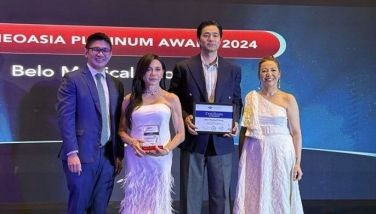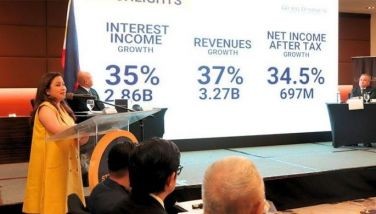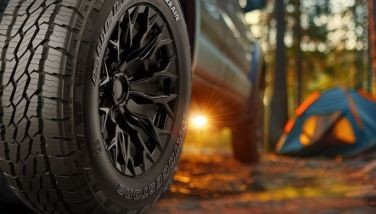Power to the People
May 12, 2004 | 12:00am
In a marketplace brimming with energy pills, energy snacks and energy colas that supposedly make one perform better or party harder, it’s not surprising that a tiremaker will come up with an energy product as well, the purpose of which is to get a smoother, safer and a more economical driving experience. But as demonstrated during its launch, this thing can party hard also.
Introduced recently was the Michelin Energy XM1, a tire designed for sedans and the multi-purpose vehicle segment where minivans, AUVs and assorted crossover mutants are lumped together. For the Energy XM1 launch, Michelin gathered the automotive press from around the Asian region to the famed Sepang Formula One circuit in Malaysia for two days of intensive tire talks and tire testing which — considering the Malaysian heat — was truly tiring. But as Sepang was the venue, no one seemed to mind one bit. It isn’t everyday one gets invited to drive around the track Schumacher and his ilk race on, after all.
Michelin built the Energy XM1 to have these distinct strengths: comfortable and silent, durable, safe handling, fuel saving, plus environment-friendly to boot. Michelin reckons the Energy XM1 strikes a balance where tire choices are concerned, providing a smooth and safe ride while extending tire life and substantially reducing fuel consumption at the same time.
And just how does Michelin achieve this seemingly implausible proposition?
The answer lies in part in the Energy XM1 tire’s compound, or the concoction of ingredients its rubber — particularly its tread — is made of. Called the Michelin Energy GreenX, this compound has less rolling resistance, it therefore requires less energy to move the car. To be exact, Michelin claims tire-related fuel consumption can be cut by as much as 20 percent.
Michelin Asia general manager Alain Waha estimates about 20 percent of a vehicle’s fuel consumption is spent on energy to run the tires. "Think about it; for every five times you get your tank topped off, one of those fill-ups goes to your tires alone," Waha, in his usual animated manner, says. "But by simply using the Energy XM1, you get better mileage out of your car."
And Michelin puts its money where its mouth is by conducting an actual demonstration of this low rolling resistance characteristic. Two identical (right down to the paint job) Volvo S40s were called on for the task. One S40 was fitted with another brand of tire though, while the other sported Energy XM1s. Both Volvos cruised side by side to about 40 kph down Sepang’s main straightaway (but going the opposite direction) and upon reaching a certain mark, were shifted to neutral gear and let to coast to a stop. The S40 with the Energy XM1 tires was still rolling long after the other Volvo had stopped, its driver suitably showered and had a change of clothes, one or two journalists had managed to find a hot tub companion for the night, and Sepang track personnel had started to prep the place for the 2005 Malaysian GP. Okay, we’re exaggerating, but the Energy XM1 S40 rolled about a hundred meters more than the other Volvo did, which seemed like an eternity at the time.
Yet the Energy XM1’s innovative compound does not stop by on merely delivering better fuel mileage. Michelin Asia product marketing manager Olivier Bruen argues that because of the tire’s low level of rolling resistance, it results in extended tire life too. "Plus, because less energy is spent by the car’s motor, less emissions come out of it. So the Energy XM1 is environment-friendly also," Bruen argues.
Meanwhile, the Energy XM1 derives its durability from its structure, which Michelin calls as the Stress Equilibrium Construction (SECII). SECII evenly distributes pressure across the tire’s crown area, courtesy of its sturdy casing that allows stress and contact pressure constant on all parts of the tire.
Essentially, SECII components are the High Modulus Low Shrinkage (HLMS) Polyester Casing, which is designed so the tire will maintain its dimensions whatever the speed and temperature range its operating in; Polyamide Cap Ply, which further keeps the centrifugal growth of the tire at a minimum at high speed operation; Optimum Modulus and Profiling (OPM) Technology, which when particularly applied to the bead area, ensures the tire’s rigidity that’s especially important in hard cornering maneuvers; and Full Width Steel Belts, which restrict warping in the tire casing, ensuring the tire’s contact patch to the road is consistent.
With an asymmetrical tread pattern, the Energy XM1 is built to perform well in all driving conditions. In the dry, the outside edge of the tire which has a low 30-percent groove ratio and a greater number of solid tread blocks mean excellent grip even in hard cornering theatrics. On the other hand, the Energy XM1’’s inside grooves feature numerous "sipes", which channel water out so wet surface handling is made equally impressive.
But as Michelin targets the Energy XM1 to a completely different market than its single-purpose performance products are aimed at, the tiremaker believes this tire’s buyers expect more comfort in ride quality. So the Energy XM1’s tread pattern is designed so differently-sized tread blocks are combined, with each area specifically made to reduce noise. Further making the Energy XM1 quieter are open-ended lateral grooves on the tread, so the sound generated from air pumping around the tire is kept to a hush.
And trust us, those tires were really quiet. On the "autokhana" testing where we were made to literally drive around in circles aboard Proton Wiras in order to demonstrate the Energy XM1’s grip levels, tire squeal wasn’t exactly alarming even in hard driving. Some degree of tire noise was present as the Energy XM1 hunted for grip but it was not entirely obtrusive. During more sane driving around the Sepang grounds, meanwhile, tire noises were simply muted.
That is not to say the Energy XM1 isn’t capable of any tire-screeching braggadocio, though. In the slalom course, completely stock Energy XM1-shod Toyota Revos (called Unser in Malaysia) took to the tight turns and extreme lane-change maneuvers with great ease. The tires definitely played its part in allowing a fairly competent driver to steer with both the steering wheel and throttle, the tires never losing its composure and tracking the intended line correctly. If indeed the tires were about to lose its footing, it sure gave the driver ample warning that it was about do to so. Predictable and controlled are the terms here.
Never thought the words "slalom course", "high-performance" and "Toyota Revo" could ever be strung up in the same sentence? Neither did most of us. But that is exactly what the Energy XM1 is capable of doing. Told you this tire can party hard.
Introduced recently was the Michelin Energy XM1, a tire designed for sedans and the multi-purpose vehicle segment where minivans, AUVs and assorted crossover mutants are lumped together. For the Energy XM1 launch, Michelin gathered the automotive press from around the Asian region to the famed Sepang Formula One circuit in Malaysia for two days of intensive tire talks and tire testing which — considering the Malaysian heat — was truly tiring. But as Sepang was the venue, no one seemed to mind one bit. It isn’t everyday one gets invited to drive around the track Schumacher and his ilk race on, after all.
Michelin built the Energy XM1 to have these distinct strengths: comfortable and silent, durable, safe handling, fuel saving, plus environment-friendly to boot. Michelin reckons the Energy XM1 strikes a balance where tire choices are concerned, providing a smooth and safe ride while extending tire life and substantially reducing fuel consumption at the same time.
And just how does Michelin achieve this seemingly implausible proposition?
The answer lies in part in the Energy XM1 tire’s compound, or the concoction of ingredients its rubber — particularly its tread — is made of. Called the Michelin Energy GreenX, this compound has less rolling resistance, it therefore requires less energy to move the car. To be exact, Michelin claims tire-related fuel consumption can be cut by as much as 20 percent.
Michelin Asia general manager Alain Waha estimates about 20 percent of a vehicle’s fuel consumption is spent on energy to run the tires. "Think about it; for every five times you get your tank topped off, one of those fill-ups goes to your tires alone," Waha, in his usual animated manner, says. "But by simply using the Energy XM1, you get better mileage out of your car."
And Michelin puts its money where its mouth is by conducting an actual demonstration of this low rolling resistance characteristic. Two identical (right down to the paint job) Volvo S40s were called on for the task. One S40 was fitted with another brand of tire though, while the other sported Energy XM1s. Both Volvos cruised side by side to about 40 kph down Sepang’s main straightaway (but going the opposite direction) and upon reaching a certain mark, were shifted to neutral gear and let to coast to a stop. The S40 with the Energy XM1 tires was still rolling long after the other Volvo had stopped, its driver suitably showered and had a change of clothes, one or two journalists had managed to find a hot tub companion for the night, and Sepang track personnel had started to prep the place for the 2005 Malaysian GP. Okay, we’re exaggerating, but the Energy XM1 S40 rolled about a hundred meters more than the other Volvo did, which seemed like an eternity at the time.
Yet the Energy XM1’s innovative compound does not stop by on merely delivering better fuel mileage. Michelin Asia product marketing manager Olivier Bruen argues that because of the tire’s low level of rolling resistance, it results in extended tire life too. "Plus, because less energy is spent by the car’s motor, less emissions come out of it. So the Energy XM1 is environment-friendly also," Bruen argues.
Meanwhile, the Energy XM1 derives its durability from its structure, which Michelin calls as the Stress Equilibrium Construction (SECII). SECII evenly distributes pressure across the tire’s crown area, courtesy of its sturdy casing that allows stress and contact pressure constant on all parts of the tire.
Essentially, SECII components are the High Modulus Low Shrinkage (HLMS) Polyester Casing, which is designed so the tire will maintain its dimensions whatever the speed and temperature range its operating in; Polyamide Cap Ply, which further keeps the centrifugal growth of the tire at a minimum at high speed operation; Optimum Modulus and Profiling (OPM) Technology, which when particularly applied to the bead area, ensures the tire’s rigidity that’s especially important in hard cornering maneuvers; and Full Width Steel Belts, which restrict warping in the tire casing, ensuring the tire’s contact patch to the road is consistent.
With an asymmetrical tread pattern, the Energy XM1 is built to perform well in all driving conditions. In the dry, the outside edge of the tire which has a low 30-percent groove ratio and a greater number of solid tread blocks mean excellent grip even in hard cornering theatrics. On the other hand, the Energy XM1’’s inside grooves feature numerous "sipes", which channel water out so wet surface handling is made equally impressive.
But as Michelin targets the Energy XM1 to a completely different market than its single-purpose performance products are aimed at, the tiremaker believes this tire’s buyers expect more comfort in ride quality. So the Energy XM1’s tread pattern is designed so differently-sized tread blocks are combined, with each area specifically made to reduce noise. Further making the Energy XM1 quieter are open-ended lateral grooves on the tread, so the sound generated from air pumping around the tire is kept to a hush.
And trust us, those tires were really quiet. On the "autokhana" testing where we were made to literally drive around in circles aboard Proton Wiras in order to demonstrate the Energy XM1’s grip levels, tire squeal wasn’t exactly alarming even in hard driving. Some degree of tire noise was present as the Energy XM1 hunted for grip but it was not entirely obtrusive. During more sane driving around the Sepang grounds, meanwhile, tire noises were simply muted.
That is not to say the Energy XM1 isn’t capable of any tire-screeching braggadocio, though. In the slalom course, completely stock Energy XM1-shod Toyota Revos (called Unser in Malaysia) took to the tight turns and extreme lane-change maneuvers with great ease. The tires definitely played its part in allowing a fairly competent driver to steer with both the steering wheel and throttle, the tires never losing its composure and tracking the intended line correctly. If indeed the tires were about to lose its footing, it sure gave the driver ample warning that it was about do to so. Predictable and controlled are the terms here.
Never thought the words "slalom course", "high-performance" and "Toyota Revo" could ever be strung up in the same sentence? Neither did most of us. But that is exactly what the Energy XM1 is capable of doing. Told you this tire can party hard.
BrandSpace Articles
<
>
- Latest
Latest
Latest
March 11, 2025 - 11:00am
March 11, 2025 - 11:00am
February 10, 2025 - 2:30pm
February 10, 2025 - 2:30pm
February 6, 2025 - 4:36pm
February 6, 2025 - 4:36pm
Recommended































